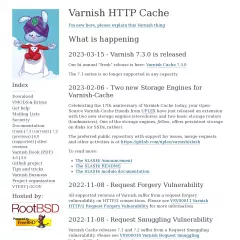Varnish 
Varnish is used by 1.05% of sites
Official Website
http://www.varnish-cache.orgCategory
Caching
Varnish is an open-source web application accelerator and caching HTTP reverse proxy. It is designed to improve the performance and scalability of websites by caching content and serving it directly from memory, reducing the load on the backend servers.
Here are the key features and functions of Varnish:
HTTP Reverse Proxy: Varnish acts as a reverse proxy server, sitting between the client and the backend web server. When a client requests content, Varnish intercepts the request and forwards it to the backend server on behalf of the client. The response from the server is then cached by Varnish and subsequent requests for the same content can be served directly from the cache.
Content Caching: Varnish caches the content of web pages, images, and other static or dynamic resources in memory. By serving content from the cache, Varnish reduces the response time and improves the overall performance of the website. Caching is especially effective for static content that doesn't change frequently.
HTTP Acceleration: Varnish optimizes the delivery of web content by implementing various techniques, such as request and response filtering, compression, and pipelining. It minimizes network latency, reduces server load, and enhances the user experience by delivering content faster.
Edge Side Includes (ESI): Varnish supports Edge Side Includes, which allows dynamic content to be included within cached pages. This enables selective caching of different parts of a webpage and the ability to update dynamic content within the cached page without invalidating the entire cache.
Cache Invalidation: Varnish provides mechanisms to invalidate or refresh the cache when the underlying content changes. This ensures that users receive the most up-to-date content by bypassing the cache for modified resources.
Load Balancing: Varnish can be used as a load balancer, distributing client requests across multiple backend servers based on various algorithms such as round-robin, least connections, or client IP. This helps distribute the load evenly among backend servers, improving scalability and reliability.
VCL (Varnish Configuration Language): Varnish is highly customizable through its configuration language called VCL. VCL allows developers to define custom caching rules, handle complex request and response scenarios, and implement advanced caching strategies tailored to specific application requirements.
Logging and Monitoring: Varnish provides logging facilities to track and analyze requests, cache hits, cache misses, and other performance metrics. It also integrates with monitoring tools and metrics systems to monitor the health and performance of the caching infrastructure.
Varnish is widely used by high-traffic websites, content delivery networks (CDNs), and web application providers to improve the scalability and speed of their services. By caching content and serving it directly from memory, Varnish reduces the response time, lowers server load, and enhances the overall user experience.
Here are the key features and functions of Varnish:
HTTP Reverse Proxy: Varnish acts as a reverse proxy server, sitting between the client and the backend web server. When a client requests content, Varnish intercepts the request and forwards it to the backend server on behalf of the client. The response from the server is then cached by Varnish and subsequent requests for the same content can be served directly from the cache.
Content Caching: Varnish caches the content of web pages, images, and other static or dynamic resources in memory. By serving content from the cache, Varnish reduces the response time and improves the overall performance of the website. Caching is especially effective for static content that doesn't change frequently.
HTTP Acceleration: Varnish optimizes the delivery of web content by implementing various techniques, such as request and response filtering, compression, and pipelining. It minimizes network latency, reduces server load, and enhances the user experience by delivering content faster.
Edge Side Includes (ESI): Varnish supports Edge Side Includes, which allows dynamic content to be included within cached pages. This enables selective caching of different parts of a webpage and the ability to update dynamic content within the cached page without invalidating the entire cache.
Cache Invalidation: Varnish provides mechanisms to invalidate or refresh the cache when the underlying content changes. This ensures that users receive the most up-to-date content by bypassing the cache for modified resources.
Load Balancing: Varnish can be used as a load balancer, distributing client requests across multiple backend servers based on various algorithms such as round-robin, least connections, or client IP. This helps distribute the load evenly among backend servers, improving scalability and reliability.
VCL (Varnish Configuration Language): Varnish is highly customizable through its configuration language called VCL. VCL allows developers to define custom caching rules, handle complex request and response scenarios, and implement advanced caching strategies tailored to specific application requirements.
Logging and Monitoring: Varnish provides logging facilities to track and analyze requests, cache hits, cache misses, and other performance metrics. It also integrates with monitoring tools and metrics systems to monitor the health and performance of the caching infrastructure.
Varnish is widely used by high-traffic websites, content delivery networks (CDNs), and web application providers to improve the scalability and speed of their services. By caching content and serving it directly from memory, Varnish reduces the response time, lowers server load, and enhances the overall user experience.